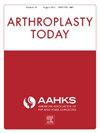Outpatient Versus Inpatient Total Joint Arthroplasty: Do Medically and Socially Complex Patients Require More Resources but Achieve Similar Outcomes?
IF 1.5
Q3 ORTHOPEDICS
引用次数: 0
Abstract
Background
This study compared outcomes between patients undergoing outpatient total joint arthroplasty (TJA) at an ambulatory surgery center (ASC) versus a cohort of medically and socially complex patients undergoing TJA at a tertiary healthcare system.
Methods
An institutional database at a single academic center was retrospectively reviewed for patients who underwent primary TJA since the opening of an ASC from August 2021 to January 2024. A total of 716 (outpatient: 374; inpatient: 342) total knee arthroplasties and 458 (outpatient: 196; inpatient: 262) total hip arthroplasties met inclusion criteria.
Results
Patients in the inpatient total knee arthroplasty group had a higher proportion of patients requiring an emergency department visit (11.4% vs 4.5%; P = .008) and admission (6.7% vs 2.7%; P = .025) within the first 90 days after surgery than the outpatient group; however, 2-year revision-free (97.9% vs 97.9%; P = .75) survival was similar between groups. Patients in the inpatient total hip arthroplasty group had a higher proportion of patients requiring an emergency department visit (13.0% vs 4.6%; P = .035) and admission (7.3% vs 1.0%; P = .018) within the first 90 days after surgery compared to the outpatient group; however, there was no difference in 2-year revision-free survival (96.4% vs 99.5%; P = .059).
Conclusions
Medically and socially complex patients undergoing TJA required additional resources during the 90-day postoperative window; however, they achieved similar survivorship as patients who met criteria for outpatient surgery.
门诊与住院患者全关节置换术:医学和社会复杂的患者需要更多的资源但获得相似的结果吗?
本研究比较了在门诊手术中心(ASC)接受门诊全关节置换术(TJA)的患者与在三级医疗保健系统接受TJA的医学和社会复杂患者的结果。方法回顾性分析自2021年8月至2024年1月ASC开放以来,单个学术中心的机构数据库中接受原发性TJA的患者。共716例(门诊:374例;住院:342例,全膝关节置换术458例(门诊:196例;住院患者:262例)全髋关节置换术符合纳入标准。结果住院全膝关节置换术组患者需要急诊科就诊的比例较高(11.4% vs 4.5%;P = 0.008)和入院率(6.7% vs 2.7%;P = .025),术后90天内较门诊组明显增高;然而,2年无修订(97.9% vs 97.9%;P = 0.75)组间生存率相似。住院全髋关节置换术组患者需要急诊科就诊的比例更高(13.0% vs 4.6%;P = 0.035)和入院率(7.3% vs 1.0%;P = 0.018),术后90天内与门诊组比较;然而,2年无修改生存率无差异(96.4% vs 99.5%;P = .059)。结论医学和社会复杂的TJA患者在术后90天需要额外的资源;然而,他们的生存率与符合门诊手术标准的患者相似。
本文章由计算机程序翻译,如有差异,请以英文原文为准。
求助全文
约1分钟内获得全文
求助全文
来源期刊

Arthroplasty Today
Medicine-Surgery
CiteScore
2.90
自引率
0.00%
发文量
258
审稿时长
40 weeks
期刊介绍:
Arthroplasty Today is a companion journal to the Journal of Arthroplasty. The journal Arthroplasty Today brings together the clinical and scientific foundations for joint replacement of the hip and knee in an open-access, online format. Arthroplasty Today solicits manuscripts of the highest quality from all areas of scientific endeavor that relate to joint replacement or the treatment of its complications, including those dealing with patient outcomes, economic and policy issues, prosthetic design, biomechanics, biomaterials, and biologic response to arthroplasty. The journal focuses on case reports. It is the purpose of Arthroplasty Today to present material to practicing orthopaedic surgeons that will keep them abreast of developments in the field, prove useful in the care of patients, and aid in understanding the scientific foundation of this subspecialty area of joint replacement. The international members of the Editorial Board provide a worldwide perspective for the journal''s area of interest. Their participation ensures that each issue of Arthroplasty Today provides the reader with timely, peer-reviewed articles of the highest quality.
 求助内容:
求助内容: 应助结果提醒方式:
应助结果提醒方式:


